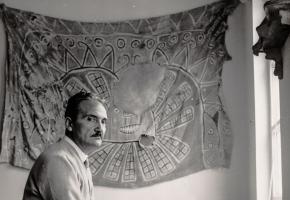With the English translations of The Savage Detectives and his magnum opus 2666, the late Roberto Bolaño has become one of the decade’s must-read authors. His books have been appearing on the bestseller lists, the book-of-the-year lists, and critics have been lauding him as the best thing to come out of Latin America since Gabriel García Marquez.
Bolaño, however, did not believe that he had much in common with many of the most popular boom authors, singling out visionary talents such as the Argentine Jorge Luis Borges as his inspiration. Like Borges, his work is wonderfully engaging and magnificently constructed. However, whilst Borges often wrote fantastical, surreal, and metaphysical works, Bolaño wrote essentially realist fiction, veritable tour de forces that leave the reader voyaging from country to country, encountering a multitude of scenarios and settings, and building up a picaresque impression of Bolaño and his many characters.
Latin American man
Bolaño was born in Santiago de Chile in 1953 and grew up in various small Chilean towns. At 15 his family moved to Mexico City, and it was here that he actively became interested in reading and writing, often foregoing school in favour of stealing books and scribbling poetry. He would travel overland back to Chile in 1973, just before Pinochet’s coup, and was briefly imprisoned before returning to Mexico City to pursue his literary studies. In 1977 he travelled to Europe and settled in Catalonia. Questioned whether he felt himself to be Chilean, Mexican, or Spanish, Bolaño always responded that he was “Latin American”.
Initially his interest was poetry, and it was not until the late 1980s that he chose to write fiction and earn more money through his writing by entering regional literary competitions. He soon found success, and by the mid-1990s could support himself and his family through writing. In 1996 his first major works were published in Spain – Nazi Literature in the Americas and Distant Star – and they gained him a substantial following and marked the beginning of a fruitful relationship with the influential publishing house Anagrama.
In 1998 Anagrama published The Savage Detectives, and it was this book that gave Bolaño widespread recognition in the Spanish-speaking world, including two prestigious literary prizes. Broadly it tells the story of Ulises Lima and Arturo Belano on their ‘literary quest’ to find an obscure Mexican poet. The stories of the two protagonists – highly auto-biographical representations of Bolaño and his friend Mario Santiago – are told not from their own perspective but from the perspective of people whom they have encountered over the 21 years and various countries (Mexico, France, Spain, Israel, Austria...) visited by the novel.
Mortality on the mind
Over the next five years Bolaño wrote incessantly. Under the shadow of death – having been diagnosed with a fatal liver disease – he wrote some shorter books (Amulet, By Night in Chile and Last Evenings on Earth), as well as literary criticism and essays. All the time, however, he was working on 2666; an epic story that would be published in 2004, the year after his death.
Just before his death, he gave the completed manuscripts to his publisher, all labelled and ready to be published. It is a novel separated into five sections which were supposed to be published as five books at a rate of one per year, in order to provide a steady income for Bolaño’s two children. It was his heirs, however, who decided to publish it as a five-part, 1,200 page tome. The book is dedicated to Alexandra and Lautaro Bolaño, and in their words the “respect for the literary value of the work [...] caused us, together with Jorge Herralde, to reverse Roberto’s decision and publish 2666 first in full, in a single volume, as he would have done had his illness not taken the gravest course”. Again the novel covers a kaleidoscopic range of characters and topics, and whilst a specific plot is not directly apparent – nor particularly important – it broadly concerns the often horrific events in a (semi-)fictional Mexican border town.
A place among the greats
In his longer works specific plot or character development is less central to his writing than his ambition to construct stories without conclusion, and stories that are open – as great literature often is – to unique interpretations on behalf of the reader. He achieves this by leaving the links between characters and stories developed yet not fully established, and thus invites the reader to meet him somewhere between their perception and his art form.
Bolaño himself has something of a myth surrounding him, something of the unknown. However, in Spain and Latin America he was a recognised author for almost 10 years before he got any sort of recognition amongst the general readership in the UK and USA. Euan Cameron – his first UK publisher – admits that Britain tends to be “slow on the uptake” when it comes to foreign literature, and that the risk-averse publishing industry often prevents the less ‘sure-fire’ novels of being translated and published, and therefore a British readership often misses out on a wealth of foreign writers.
Bolaño was first translated in 2003, mainly due to his success in Spanish-speaking countries, but it was not an overnight sensation: the complex yet thoroughly accessible nature of his writing is certainly a world apart from the easy-reading, exotic, locally-inspired drivel that often comes from Latin American authors (Coelho, Allende, Esquivel, Mastretta et al.) who are popular in English-speaking countries. It was not until 2007 that The Savage Detectives was published, and the word had spread to a sufficient extent to quickly propel it onto the best book lists and into university departments. From a publishing perspective, the uptake had exceeded the expectations, and a new Latin American star was born: someone finally justified the accolades as the best author since García Marquez and the ‘best since the boom!’.
However, such treatment of his art form is rather underwhelming. His work should not be considered in the same context as the boom, the post-boom, as García Marquez, or as Vargas Llosa. Rather he must be appreciated on his own terms, as somebody writing literature for literature’s sake and not for the sake of telling a gripping story. Did he really think about being part of a Latin American literary canon when he was writing the stories? I doubt it; rather he wrote literature because he wanted to write and it so happened that people found much to appreciate within it. Bolaño expressed his critical opinions on much Latin American literature, sparing few, and as such he is often considered by readers to be a literary rebel or myth.
The literary quest vindicated
Bolaño was not a literary rebel; in fact the contrary is true: his writing is so literary that many other authors pale in comparison. Take a theme common in The Savage Detectives and 2666 as an example: the literary quest. In the former much of the story is based around the search for an obscure poet (Cesárea Tinajero), and in the latter the search for an elusive European author (Benno von Archimboldi). His works reflect on his art, indeed his works are often self-reflective and use literature as a means to write about literature. As such all the time he demonstrates through his works his extensive commitment to and engagement with the literary form. He may often use informal language and constructions (sentences going on for page after page, for example), and at times be very amusing indeed, but make no mistake: literature is an art that Bolaño took very seriously.
Moreover, one of the most appealing aspects in his literature is his international perspective. He was a Latin American, yes, and much of his work was about Latin America but his writing demonstrated little of what Borges called “local colour”. If one is Argentinean, must one write about tango, gauchos, and the pampas? No – but many books (including many during the boom) did embellish their works with national or regional imagery that gave the books a certain exoticism and posited them very much as Latin American literature.
The universal author
Rather than resorting to local colour, Bolaño transcends national and regional boundaries. In the case of 2666, for example, the Argentine author (and close friend to Bolaño) Rodrigo Fresán has noted, “What is sought and achieved here is the Total Novel, placing the author [...] on the same team as Cervantes, Sterne, Melville, Proust, Musil and Pynchon.” Bolaño’s work is enjoyable simply as brilliant literature, regardless of where the author came from or from where the reader beholds it.
Does Bolaño merit his current surge in popularity in the UK? Yes; and the best is yet to come. 2666 and The Savage Detectives may be great books in themselves, but that is by no means the extent of his oeuvre. Almost all of his (known) work will soon be available in translation, and it is only upon reading various novels that we get an idea for his genius, a way into the mythological literary world created by Bolaño. Not only does he write wonderful books, but there are re-appearing characters and re-worked scenes between his books, a certain interconnected nature to his work that demonstrates the author’s continual engagement with his art and the appreciation of literature in general. Indeed for English speakers, it is only just beginning. Let us hope that his popularity is not a fleeting one, as this is an author who deserves more.

















